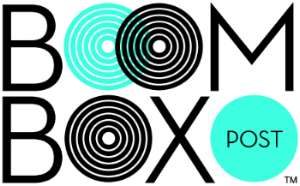A COLLABORATIVE POST
BOOM BOX POST
We recently found ourselves working on a Roller Derby themed episode for one of our shows. As you can imagine, this episode called for an abundance of roller skating sounds to cover a wide variety of performances. We quickly discovered that our sound effects library alone wasn’t going to provide all of the coverage we needed, so we sought out some other solutions. Tess Fournier and Tim Vindigni came to the rescue by volunteering their own skates and skills to record! With the guidance of Re-recording mixer Jacob Cook, the three took it upon themselves to plan and execute a recording session to help build up our library and turnover some much needed roller skating sounds for the episode.
What was the most challenging part about recording these Skate sounds?
The most challenging part of this was that I’m still pretty much a beginner skater! I wanted to make the recordings sound adept and cool, but my skating skills aren't the strongest. I tried to record fairly close-miked when I was capturing steady-skating to make the wheels sound heftier and more intense. It was pretty complicated trying to hold the recorder and mic while skating, but we wanted to avoid the sound of footsteps moving alongside the skating, and I was able to get a closer record than someone beside me could have.
— Tess Fournier
How did you create the illusion of speed for the skate-by recordings?
With Jacob's guidance and expertise, we used a whip-by tracking technique. Jacob defines the whip-by as a technique "in which the recordist whips the microphone in the opposite direction of the vehicle, like a reverse tracking by, to get a much stronger sense of speed." (Check out Jacob’s Vehicle Recording blog post where he discusses these techniques). This allowed Tess and I to worry less about how fast we sounded and skate at a speed comfortable and safe for us.
— Tim Vindigni
Which were your favorite sounds to record?
I really enjoyed when it was my turn to put on my blades and zip around. We discovered that swerving movements were much easier to record on my blades than Tess's skates. So I had a lot of fun zig-zagging around the parking lot. I think these records were a pivotal sound to capture because they add texture and help with the illusion of speed when paired with the steady skate recordings, overall providing a more epic effect!
— Tim Vindigni
Could you share Your process for editing and cleaning up these recordings?
Cleaning up the recordings wasn’t too complicated. Since we recorded outside, I did some light noise reduction (and a bit of RX help to remove a bird or two). We recorded in a parking lot behind a building to muffle traffic as much as possible and that helped mitigate fluctuations in noise in our recordings. After that I added some light compression and made sure to manually edit out any unwanted or less useful sounds. Lastly I noticed some cool scraping in the steady-skate record of Tim’s roller blades that would make great stops, so I isolated those and ramped some fades on them to make some intense sliding stops.
I think sometimes people overthink cleaning up these types of files. You don’t really need the best recording equipment, perfect recording environment, or a fancy processing chain to get good sounding files. As long as you implement solid recording techniques, try to mitigate noise as much as possible, and pay attention to your signal-to-noise ratio, the cleanup process should be fairly simple!
— Tess Fournier
if you were to conduct another skate record session would you do anything differently?
Instead of having the skater hold the microphone while recording the steadies, I think clipping a lavalier mic somewhere on the skate/blade would be very helpful and allow for much longer sequences to be recorded.
— Tim Vindigni
I really wouldn’t do anything differently. We planned ahead by making a list of the sounds we needed and planned methods for how to get our desired results (for instance, for lands and stomps, we recorded inside on our stage. I wore the skates on my hands and performed like on a foley stage. We did this to avoid the noise from outside and we also had more control than if we actually recorded lands while skating). After we planned the sounds we needed and how to capture them, we were logical and speedy about the actual recording process. We didn’t waste time, we had fun, and we ended up with some great sounding recordings! I can see these files being useful for many projects to come! Our office talked about maybe grabbing ice skating recordings at some point in the future, and I think that would be super fun!
— Tess Fournier
HOW would you go about recording roller derby sound effects?
If you enjoyed this blog, check out these:
TOP TIPS FOR EFFECTIVE FIELD RECORDING TRIPS
LUNCH & LEARN: VEHICLE RECORDING
THE WORLD IN STEREO: SOUND EFFECTS RECORDING TECHNIQUES

